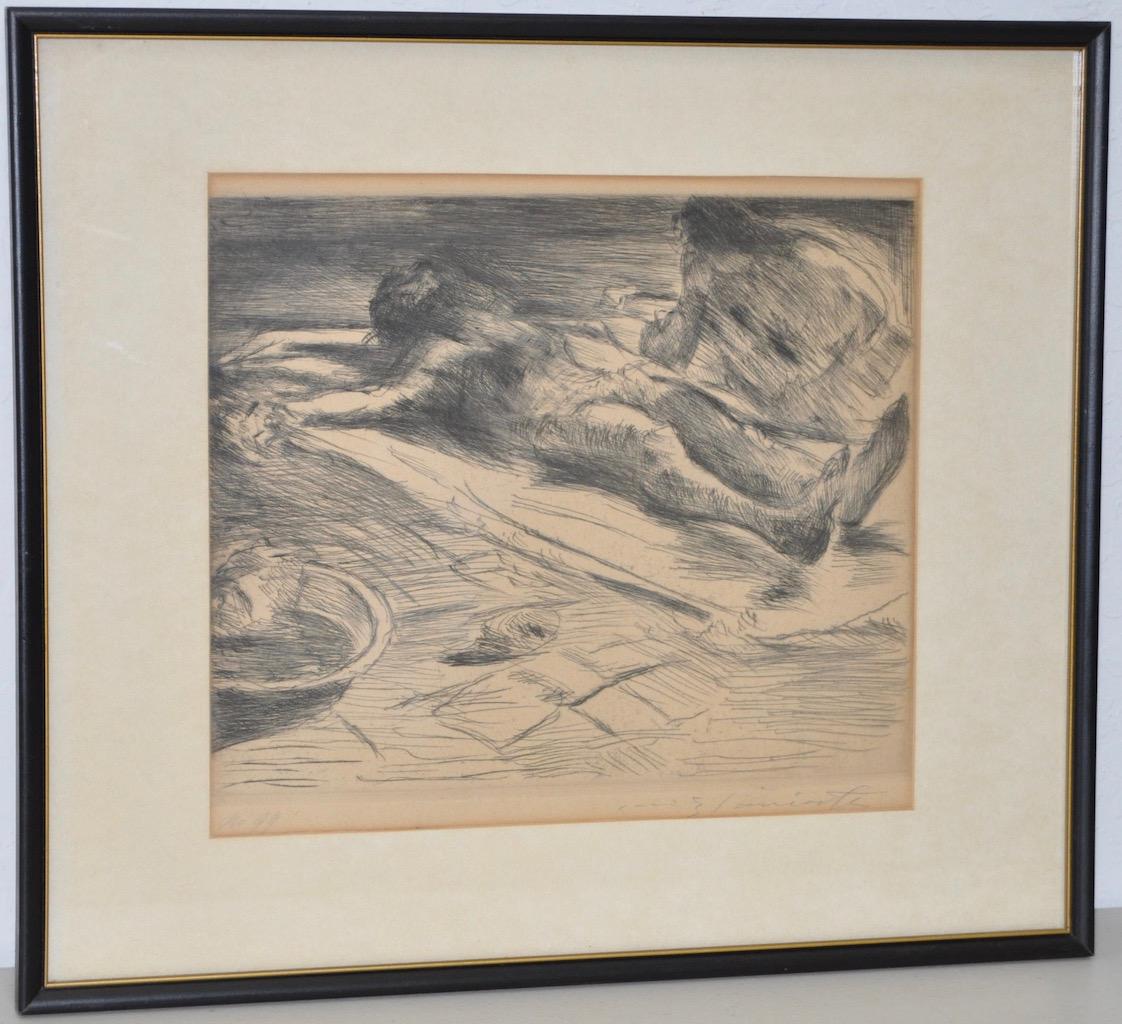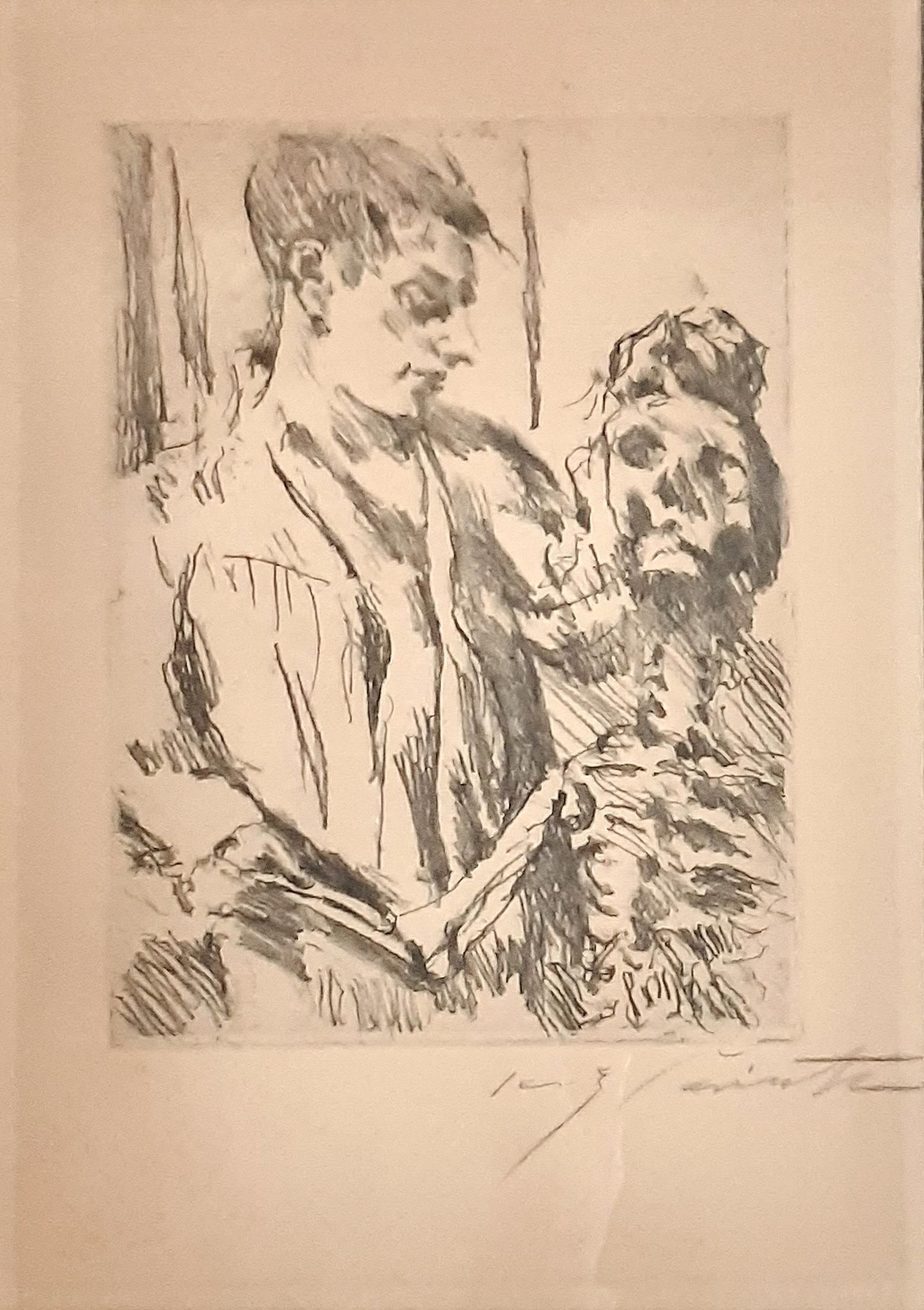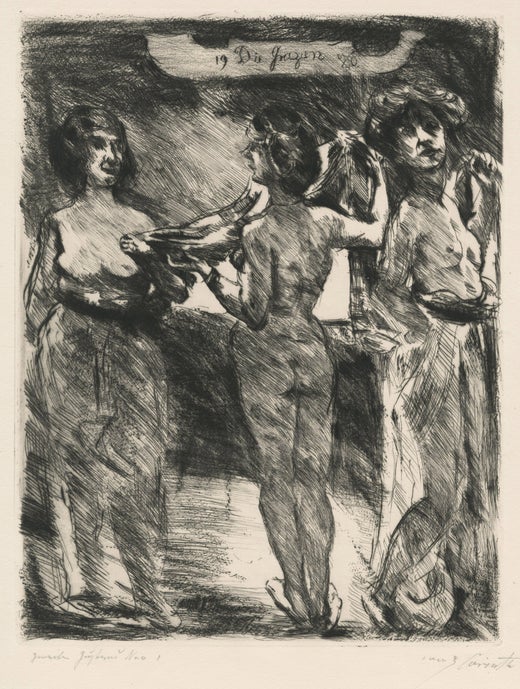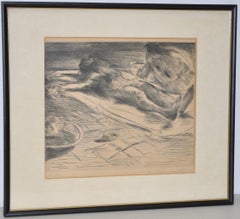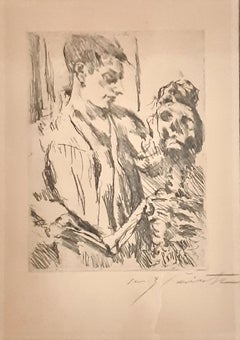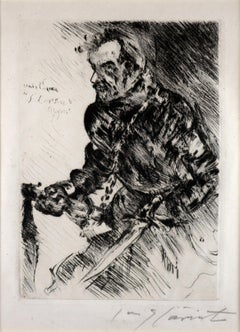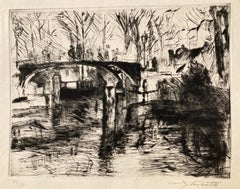Items Similar to Lovis Corinth, Badeanstalt 1920, Lithograph, Hand-Signed , German Impressionist
Want more images or videos?
Request additional images or videos from the seller
1 of 10
Lovis CorinthLovis Corinth, Badeanstalt 1920, Lithograph, Hand-Signed , German Impressionist1920
1920
$1,713.32
£1,303.87
€1,450
CA$2,398.38
A$2,642.82
CHF 1,370.79
MX$31,432.82
NOK 17,340.08
SEK 16,243.98
DKK 11,045.91
About the Item
Lovis Corinth
Tapiau 1858 - 1925 Zandvoort
Bathing Establishment, 1920
Lithograph on handmade paper
Signed in pencil lower right
Marked "Probedruck" (proof print) lower left
Image size: 32 x 36.8 cm
Frame: 57 x 60 cm
Good original condition, under passe-partout (additional photos available upon request)
Rare proof print prior to the original edition of 115 copies
Published by Fritz Gurlitt, Berlin
Catalogue raisonné Schwarz 442
Handcrafted model frame, museum glass
Viewing and pickup possible by appointment
Authenticity confirmed in writing.
Lovis Corinth was born on July 21, 1858, in the town of Tapiau in East Prussia (now Gwardejsk, Russia). While attending high school in Königsberg, he developed an interest in Greek and Roman mythology as well as the Christian stories of the Bible. From 1876, Lovis Corinth attended the art academy in Königsberg, where he studied under Otto Günther, who introduced him to Weimar plein air painting. In 1880, he transferred to the Munich Academy. Works from his Munich period demonstrate his orientation towards the naturalistic painting style of Wilhelm Leibl's circle.
In 1883, Lovis Corinth traveled to Italy with his father, and in 1884 he spent three months in Antwerp, where he took painting lessons from Paul Eugène Gorge. From 1884 to 1887, Corinth studied at the Académie Julian in Paris. The artist then traveled to Berlin, where he probably painted his first self-portrait in 1887/88, which was followed by numerous others over the years.
From 1891 to 1899, Corinth lived as a freelance painter in Munich, where he belonged to the Secession. After meeting Max Liebermann and Walter Leistikow in the winter of 1898/99, he decided to move to Berlin, where he settled in 1901. Prior to this, his work "Salomé with the Head of John the Baptist, Second Version" had been shown to great acclaim at the second exhibition of the "Berlin Secession."
In Berlin, Lovis Corinth opened a painting school. In 1903, he married Charlotte Berend, his first student. In 1904, a son is born. During this period, the motif of the mother with her child appears repeatedly in his works. Corinth's painting style, initially dark and heavy, now begins to become looser and lighter, impressionistic. His painting style always shows powerful brushstrokes and impasto application of paint. His pictures are created entirely from color. In later years, his painting takes on increasingly expressive features.
From 1907 to 1911, Lovis Corinth undertook study trips to Belgium and Holland. In 1911, Corinth was elected chairman of the "Berlin Secession," but in the same year he suffered a stroke and was left paralyzed on one side. During his convalescence from 1912 to 1914, Corinth traveled to the Riviera and South Tyrol in Italy and recovered to such an extent that he was able to paint again. After 1911, Lovis Corinth also turned his attention to graphic art with great interest, producing a wealth of etchings and lithographs, as well as book illustrations.
In 1914, the "Freie Secession" split from the "Berliner Secession," but Corinth remained with the original Secession and became its chairman again in 1915. In 1916/17, he traveled to Hamburg, the Baltic Sea, and Tapiau. In 1918, Lovis Corinth became a professor at the Academy of Arts in Berlin. In 1919, he and his wife built a country house in Urfeld am Walchensee, which served as an idyllic retreat for the next few years. This is where the "Walchensee" paintings were created.
In June 1925, Lovis Corinth traveled to Amsterdam once again, where he fell seriously ill with pneumonia and died.
- Creator:Lovis Corinth (1858 - 1925, German)
- Creation Year:1920
- Dimensions:Height: 12.6 in (32 cm)Width: 14.49 in (36.8 cm)
- Medium:
- Movement & Style:
- Period:
- Condition:
- Gallery Location:Eltville am Rhein, DE
- Reference Number:1stDibs: LU2910217168222
Lovis Corinth
Lovis Corinth was a German artist and writer whose mature work as a painter and printmaker realized a synthesis of impressionism and expressionism, known for his dramatic figurative and landscape paintings also for his landscapes of the Walchensee area of Bavaria and his portraits, Corinth also painted religious scenes, often violent . He also made etchings and lithographs in which he revealed his capacity for Expressionist power.
About the Seller
New to 1stDibs
Joined in the past six months.
No Reviews Yet
Vetted Professional Seller
Every seller passes strict standards for authenticity and reliability
1stDibs seller since 2025
- ShippingRetrieving quote...Shipping from: Eltville am Rhein, Germany
- Return Policy
More From This Seller
View AllLovis Corinth "Bergsee 1923" Color Lithograph, German Impressionist, Signed
By Lovis Corinth
Located in Eltville am Rhein, DE
Lovis Corinth
Tapiau 1858 - 1925 Zandvoort
Bergsee, 1923
Mountain Lake 1923,
Color lithograph on handmade paper
Signed in pencil lower right
Sheet 1 of the portfolio Swiss Landscap...
Category
1920s Impressionist Landscape Prints
Materials
Lithograph
Lovis Corinth "Alphütte 1923" Color Lithograph, German Impressionist, Signed
By Lovis Corinth
Located in Eltville am Rhein, DE
Lovis Corinth
Born 1858 - 1925 Zandvoort
Alpine Hut, 1923
Color lithograph on handmade paper
Signed in pencil lower right
Sheet 3 of the portfolio Swiss Landscapes
One of 75 copie...
Category
1920s Impressionist Landscape Prints
Materials
Lithograph
Lovis Corinth "Wildbach 1923" Color Lithograph, German Impressionist, Signed
By Lovis Corinth
Located in Eltville am Rhein, DE
Lovis Corinth
Tapiau 1858 - 1925 Zandvoort
Wildbach, 1923
Color lithograph on handmade paper
Signed in pencil lower right
Sheet 4 of the portfolio Swiss Landscapes
One of 75 copie...
Category
1920s Impressionist Landscape Prints
Materials
Lithograph
Lovis Corinth "Burg am See 1923" Color Lithograph, German Impressionist, Signed
By Lovis Corinth
Located in Eltville am Rhein, DE
Lovis Corinth
Tapiau 1858 - 1925 Zandvoort
Castle by the Lake 1923,
Color lithograph on handmade paper
Signed in pencil lower right
Sheet 2 of the portfolio Swiss Landscapes
One o...
Category
1920s Impressionist Landscape Prints
Materials
Lithograph
Expressionist Landscape "Mainlandschaft" Etching, 1918, Hand Signed
By Max Beckmann
Located in Eltville am Rhein, DE
Max Beckmann
Leipzig 1884 - 1950 New York
Main Landscape, 1918
Drypoint on handmade paper
Signed in pencil lower right
Image size: 25.2 x 30 cm
Paper size: 36.5 x 38 cm
Frame: 48....
Category
1910s Expressionist Landscape Prints
Materials
Etching
Lothar Homeyer "Portrait Marc Chagall 1946" German Expressionst , Ink Drawing
Located in Eltville am Rhein, DE
Lothar Homeyer
Berlin 1883 - 1969
Marc Chagall, 1946
Ink drawing, heightened in white in places on paper / cardboard
Monogrammed and dated lower right, titled lower left below th...
Category
1940s Expressionist Portrait Drawings and Watercolors
Materials
Ink
You May Also Like
Lovis Corinth (German, 1859-1925) "Pieta" Rare Etching c.1920
By Lovis Corinth
Located in San Francisco, CA
Lovis Corinth (German, 1859-1925) Rare Etching c.1920
Fine etching by noted German Expressionist artist Lovis Corinth.
This striking imag...
Category
Early 20th Century Impressionist Figurative Prints
Materials
Etching
Tod und Jungling - Lithograph by L. Corinth - 1921
By Lovis Corinth
Located in Roma, IT
Tod und Jungling is an original lithograph, realized by Lovis Corinth in 1921, hand-signed and numbered n°33/95.
Included a wooden frame.
In very good conditions.
Here the artworks represented a man with a strong expression of lines drawn, who has caught with his hand a skeleton, interestingly the skeleton has a sense of fear although the man is free of any frightening emotions.
Lovis Corinth (1858-1925) was a German artist and writer whose mature work as a painter and printmaker realized a synthesis of impressionism and expressionism. known for his dramatic figurative...
Category
1920s Figurative Prints
Materials
Lithograph
Rudolf v. Rittner as Florian Geyer - Last man standing -
By Lovis Corinth
Located in Berlin, DE
Lovis Corinth (1858 Tapiau - 1925 Zandvoort), Rudolf von Rittner as Florian Geyer, 1924 (Müller 854), drypoint signed in pencil. 20.4 × 14.2 (plate size), 37.7 × 30.6 cm (sheet size). Published by Karl Nierendorf, Berlin. Framed in a passepartout.
- Strong, precise impression. Frame a little bit rubbed and with two small damages.
About the artwork
The knight is a leitmotif in Lovis Corinth's work, culminating in his Self-Portrait in Armour of 1914. Of all the paintings on this theme, Corinth most often depicted Florian Geyer. Descended from a Franconian noble family, he fought for the freedom of the peasants during the peasant wars of the Reformation, first diplomatically and then militarily, leading the legendary Schwarzen Haufen (Black Troops). The name derives from the black uniforms with which Geyer dressed the peasants willing to fight.
During the Napoleonic occupation, the freedom fighter Florian Geyer was sung about by the Romantics, and the free corps Die Schwarze Schaar, founded in 1813 by Major von Lützow, succeeded the Schwarzer Haufen. It was against this historical background that Gerhard Hauptmann wrote the revolutionary drama Florian Geyer, which premiered at the Deutsches Theater in Berlin in 1896. While the actor Rudolf Rittner, who would later appear in Fritz Lang's films, initially played the role of Schäferhans, he took over the leading role in the new production at Berlin's Lessing Theatre in 1904, again directed by Emil Lessing, which established his fame as an actor. Hauptmann himself praised the acting. He wrote to Hugo von Hofmannsthal: "It went quite well with Florian Geyer. In any case, I had the great pleasure of seeing the play again in an admirable performance". And Lovis Corinth was so taken with Rittner's performance that he painted an oil portrait of him in the role of Florian Geyer in 1906.
After two further graphic versions in 1915 and 1920/21, Corinth returned to the painting a year before his death and almost twenty years after the oil painting to create this graphic version in 1924. Even the inscription in the picture was taken over. This proves all the more the importance of the knight and freedom fighter for Corinth's self-image.
The oil painting, in particular, proclaims the single-minded determination to fight to the last for the values defended, manifested in the oil painting by the tattered flag held out to the enemy. There is a parallel with Rainer Maria Rilke's 1899 story The Cornet, in which the protagonist goes down with the flag that he first saved at the risk of his life.
Consequently, the portrait is also a self-portrait, and the knight's armour is not an academic costume or an ironic refraction, but an expression of Corinth's self-image, which also includes his self-representation as an artist. The Secession poster...
Category
1920s Expressionist Figurative Prints
Materials
Etching
$898 Sale Price
20% Off
AUS DEM TIERGARTEN
By Lovis Corinth
Located in Santa Monica, CA
LOVIS CORINTH (1858-1925)
AUS DEM TIERGARTEN 1920 (Schwartz 397)
Drypoint, signed and numbered 47/50. BEAUTIFUL IMPRESSION with RICH DRYPOINT. Plate 9 ½ x 12 ½ inches. Full margins...
Category
1920s Impressionist Prints and Multiples
Materials
Drypoint
Berg See (Mountain Lake)
By Lovis Corinth
Located in Palm Springs, CA
Title: Mountain Lake (Berg see)
Creator: Lovis Corinth
Date Created: 1922
Signatures / Inscriptions: Signed by artist
Set or Series Title: Early Spring in the Mountains (Vorfrühling ...
Category
1920s Expressionist Landscape Prints
Materials
Lithograph
Gullivers Reise - Rare Book Illustrated by Lovis Corinth - 1922
By Lovis Corinth
Located in Roma, IT
Gullivers Reise is an original modern rare book written by Jonathan Swift (Dublin, 1667 – Dublin, 1745) and illustrated by Lovis Corinth (21 July 1858 –...
Category
1920s Expressionist More Art
Materials
Paper
